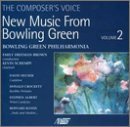
Cauldron
|
Play Cauldron from a live performance
|
Composer: David Heuser Instrumentation: Orchestra (3232 4231, pno, harp, timp, 3 perc, strings) Year Composed: 1995 Duration: 8 minutes Pages (score): 38
Recording:
Representative Performances:
Percussion Required: 4 tomtoms, 2 timbales, snare drum, bass drum, triangle, 3 suspended cymbals, xylophone, vibraphone, crotales [one octave] Reviews: Performance by the Eugene Symphony, Miguel Harth-Bedoya, conductor, reviewed in the Register-Guard (Eugene, OR) by Michael Souther on 5/29/97:
"After intermission, Miguel Harth-Bedoya and the orchestra presented the West Coast premiere
of a work commissioned by Harth-Bedoya for the New York Youth Symphony. Composed by
David Heuser in 1995, "Cauldron" is an exciting, dynamic tour-de-force, with a relentless
ostinato, here taken up by the piano, then the harp, then migrating around the ensemble, never
completely disappearing.
The performance was excellent, the large orchestra was at its best, and the energy never waned.
All sections of the orchestra got to shine in turn, and the playing left one full of admiration both
for the musicians and for the young composer of this fine work."
The same performance reviewed by Fred Crafts on GaurdLine 5/15/97:
"Although the orchestra seemed uninspired with Mozart's overture to "The Abduction from the
Seraglio," it certainly connected with Heuser's propulsive "Cauldron." This raucous
contemporary piece, being given its West Coast premiere, was built on a driving rhythm pattern
that erupted into cha-cha-chas, with brass and percussion that stirred the blood."
Testimonial "I must tell you that your composition turned out to be the 'hit' of the summer for my orchestra. But it didn't start out that way. Dear old Harold - age 91(!) - asked after about half of our first attempted reading, "who the heck is David Howser?" I explained who David 'Hiser' is... Of course for that first reading I had no percussion, and may of the inner parts were not successfully counted! A couple of nights later Harold called and practically begged me not to play the piece. I tactfully explained we needed to give it some more time. After the second rehearsal and another hearing of the CD - and my gathering of some percussion troops - a majority were warming to Cauldron and by the third rehearsal they were fired up.
We played some other interesting and enjoyable music last summer. But the piece which was the most memorable and about the orchestra felt most proud was Cauldron."
A near-continuous eighth-note ostinato is the main thread running through the piece,
providing a backdrop over which the rest of the music is heard. Ostinati are common in my
music, and I often think of them as a metaphor for the unchanging, uncaring universe over
which time, history and our lives play out. Even though this ostinato affects and is affected by
the foreground music, I feel the metaphor holds true in this piece as well. Despite that, this is
not a programmatic piece; if anything it has neo-classical sensibilities.
Formally, the piece divides into three sections which could be labeled A-B-A', although
the second A section spends a substantial amount of time exploring a new area. The outer
sections are generally more active and louder than the central section (although both A sections
begin softly), and focus on fragments of melody and short threefold repetitions of chords. In
contrast, the middle part of the piece features longer legato lines played by solo wind
instruments. Eventually, though, these lines are also fragmented and slowly piled up on each
other in a gradually crescendo of activity.
Although this piece has strong tone centers, it is not traditionally tonal like 18th- and
19th-century music. In the outer sections, the repetitive eighth-notes center around G; in the
middle section it is E that is the primary pitch. Only once does the eighth-note pulse stop, and
that is during the transition from the B section to the return of A. Near the end of the piece,
however, the ostinato transforms, and instead of pitched eighth-notes, it becomes sixteenth-notes
played by drums.
|
|
|
|
Non Sequitur Music Publishing 2112 Ontario Street Bellingham, WA 98229 USA (360) 733-7145 Email: nsm@nonsequiturmusic.com |
Copyright © 1998; 2008, Non Sequitur Music Publishing
These pages are continually revised and updated. Email any questions about this page to webmaster@nonsequiturmusic.com
|
